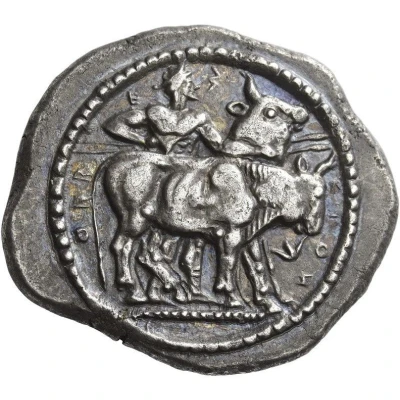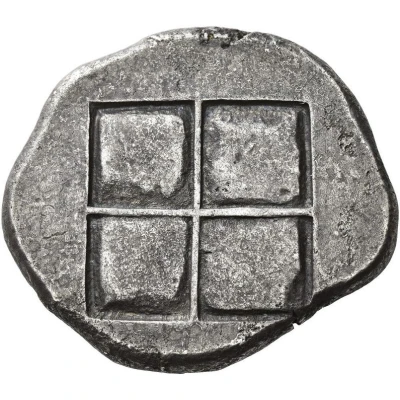


Octodrachm 479 BC - 465 BC
| Silver | 28.80 g | - |
| Issuer | Orreskioi (Thraco-macedonian region) |
|---|---|
| Type | Standard circulation coin |
| Years | 479 BC - 465 BC |
| Value | Octadrachm (8) |
| Currency | Drachm |
| Composition | Silver |
| Weight | 28.80 g |
| Shape | Round (irregular) |
| Technique | Hammered, Incuse |
| Demonetized | Yes |
| Updated | 2024-10-10 |
| Numista | N#387556 |
|---|---|
| Rarity index | 100% |
Reverse
Quadripartite incuse square.
Comment
AMNG III 2, pl. XVIII, 2; Traité I, 1462 and pl. XLV, 10; Svoronos, Hellénisme Primitif, P56, 5 and pl. V, 4.
The Thraco-Macedonian region had an abundance of gold and silver mines, notably in the rich mining district around Mount Pangaeus, which were worked by the local tribes and foreigners, including the Thasians, who kept a foothold on the mainland. The mineral riches also attracted the interest of the Athenians, who defeated the Thasians in 463 and again in 375 B.C. so as to take over their mainland settlements. It is clear that the Macedonian kings intervened in the commercial affairs of their northern neighbours, for they issued a great quantity of silver coinage during the period c.498 to c.369 B.C. Soon afterward, Philip II annexed the Pangaean region, finding great success in his mining activities, which allowed him and his son, Alexander III, to use their newfound wealth to transform their kingdom from a regional to an international power. Coin production by tribes in the region seems to have occurred principally from about 530 to 450 B.C., with the bulk of the large-denomination issues apparently being issued from c.485 to 460 B.C. It has long been suggested that these large silver coins would have been inconvenient for local needs, but this cannot be taken for granted. Even though hoard evidence shows that they were exported to the Near East, the Levant, and Egypt, that does not preclude the prospect of their local use. One need only consider the traditions of large, cast bronze money in Central Italy for a more dramatic parallel. Large denomination silver coins of tribes in this region often shared designs. This octodrachm (or tristater) of the Orrescii, a tribe known only from its coinage, bears an obverse composition that is virtually identical to that found on coins of the same denomination issued contemporarily by the Edones, the Ichnai and the Tyntenoi. The meaning of this design, which shows a naked, bearded man wearing a Causia and holding two spears, conducting two oxen, the nearer with its head lowered, the further with its head raised, is not certainly known. The figure may be a herdsman or a local hero performing a feat from some local myth which, perhaps, is represented in a different format on coins of the Derrones, on which a man drives an ox-cart. The most common belief, however, is that the figure is the god Hermes in the midst of stealing the cattle of the sun. This view might find support in a contemporary dodecadrachm of the Derrones (Svoronos, L'Hellénisme primitif de la Macédoine, pl. I, 8) that shows on its obverse a man standing between two oxen, but instead of spears he holds a caduceus.
Interesting fact
One interesting fact about the Octodrachm coin from Orreskioi is that it features a unique combination of Thracian and Macedonian elements on its design. The obverse side of the coin depicts a Thracian horseman, while the reverse side features a Macedonian-style image of a lion attacking a stag. This blending of cultural influences reflects the rich cultural diversity of the region during that time period.